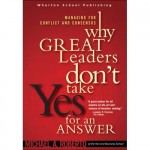Decision-Making and Leadership
 A book that was recently introduced to me by a good friend has validated and deepened my view on leadership, how decisions get made and trust. “Why Great Leaders Don’t Take Yes For An Answer”, written by Professor Michael Roberto, speaks to the value of a decision-making process that focuses on “deciding how to decide” versus the purely efficient approach of finding the “right solution” to a problem. Focusing on the “decision-making process” has tremendous benefit around building trust in and across organizations. Why?
Senior leaders rightfully see themselves as charged with making the right decisions for their organizations. They have a genetic disposition to seeing a problem and quickly identifying the solution. Isn’t this what we expect from those in charge? But what if being in charge is less about having the right answers and more about using the people around you to come up with the “best solution”? This is one of the premises of Michael Roberto’s book.
A book that was recently introduced to me by a good friend has validated and deepened my view on leadership, how decisions get made and trust. “Why Great Leaders Don’t Take Yes For An Answer”, written by Professor Michael Roberto, speaks to the value of a decision-making process that focuses on “deciding how to decide” versus the purely efficient approach of finding the “right solution” to a problem. Focusing on the “decision-making process” has tremendous benefit around building trust in and across organizations. Why?
Senior leaders rightfully see themselves as charged with making the right decisions for their organizations. They have a genetic disposition to seeing a problem and quickly identifying the solution. Isn’t this what we expect from those in charge? But what if being in charge is less about having the right answers and more about using the people around you to come up with the “best solution”? This is one of the premises of Michael Roberto’s book.
It makes perfect sense to solve a problem quickly when the issue is straightforward or lacks complexity. Asking for collaboration when there is no intention to consider alternatives is disingenuous and only serves to diminish trust.
However, there are many more decisions that would benefit from rigorous dialogue before coming to a decision. Cutting work force, expanding to different markets or generating new revenue streams are all examples of decisions that have many layers of complexity. In these cases, bringing the right people together having the right conversations increases the likelihood of a well thought out solution. And with the presence of honest dialogue, a higher level of trust can develop between parties.
If we find ways to encourage participation in problem solving, starting with “deciding how to decide”, our leaders and managers will be jumping out bed to get to work and participate in healthy debates. This is exciting work and gets people powerfully engaged. Not only will you get better results, but you’ll see trust in action.
You can also find Professor Michael Roberto’s blog at http://michael-roberto.blogspot.com/.
